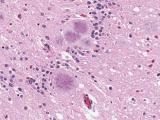Sep 20, 2001 (CIDRAP News) – A new immunoblot method for detecting prion protein related to variant Creutzfeldt-Jakob disease (vCJD) is much more sensitive than existing bioassay techniques, according to a recent report in The Lancet. The new assay revealed significant amounts of prion protein in the eye tissue of vCJD patients, prompting researchers to suggest that ophthalmic surgical instruments may pose a risk of transmitting the disease.
"Ophthalmic surgical instruments used in procedures involving optic nerve and the posterior segment of the eye, in particular the retina, might represent a potential risk for iatrogenic transmission via biopsy instruments," state J.D.F. Wadsworth and colleagues in the summary of their article. Their test did not detect prion protein in anterior structures of the eye.
The authors note that bioassay can be used to confirm infection when prions are transferred between individuals of the same species, but species barriers limit the infectivity of vCJD prions transferred from bovine or human tissue to rodents. Pending the development of a bioassay technique that overcomes species barriers, they write, "We reasoned that useful data to inform vCJD risk assessments would best be gained from high sensitivity immunodetection" of disease-related prion protein (PrPSc).
The researchers collected tissue from four patients who had died of probable vCJD—a diagnosis that was confirmed at autopsy with the detection of PrPSc in brain tissue—and gathered control tissue from patients who had died of nonneurologic causes. A previously described method involving sodium phosphotungstic acid was used to selectively precipitate PrPSc from tissue homogenates, an approach that permits concentration of prion protein from much larger volumes of tissue than can be injected into mice for bioassays. A Western blot technique with high-sensitivity enhanced chemiluminescence then was used to detect PrPSc in the precipitates.
The authors report that they detected PrPSc in the equivalent of 50 nL of 10% homogenates of vCJD brain tissue and were able to detect PrPSc in tissue homogenates in concentrations 10-4 to 10-5 of those found in brain tissue. Tonsil, spleen, and lymph node tissues all contained PrPSc in concentrations ranging from 0.1% to 15% of those found in brain tissue, with tonsils consistently having the highest concentrations. Analyses of eye tissue revealed prion protein in the retina and optic nerve at levels 2.5% and 25% of those in brain tissue, respectively, but none was found in other components of the eye (though assays of the latter components were less sensitive because of the limited amounts of tissue available). Nor was PrPSc found in eye tissue from a patient who had sporadic CJD.
Other peripheral tissues analyzed yielded no evidence of PrPSc, except for low levels found in the rectum, adrenal gland, and thymus of one patient with vCJD. No PrPSc was found in the appendix or the buffy coat fraction of blood from vCJD patients.
The researchers conclude that their finding of higher concentrations of PrPSc in tonsils than in other lymphoreticular tissues supports the recommendation by United Kingdom health officials to use disposable instruments for tonsillectomies. Further, their assay could be used in large-scale screening of surgical lymphoreticular tissues to assess the prevalence of preclinical vCJD in the UK population. They add, "The presence of PrPSc in rectum highlights the potential for iatrogenic transmission of vCJD via instruments used in rectal biopsy, a common clinical procedure. Biopsy of other gastrointestinal tissue, which may have a higher lymphoreticular component than rectum, should be considered as a concern for iatrogenic transmission of vCJD prions."
Wadsworth JDF, Joiner S, Hill AF, et al. Tissue distribution of protease resistant prion protein in variant Creutzfeldt-Jakob disease using a highly sensitive immunoblotting assay. Lancet 2001;358(9277):171-80
Full text (Access may require free registration.)















